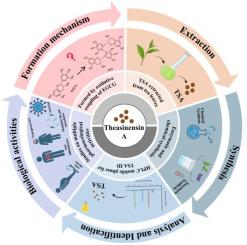Theasinensin A: Formation, preparation, and bioactivities of a promising functional polyphenol in tea
IF 15.4
1区 农林科学
Q1 FOOD SCIENCE & TECHNOLOGY
引用次数: 0
Abstract
Background
Theasinensin A (TSA), a type of ester-linked catechin dimer, is a polyphenolic compound formed through oxidative condensation of catechins during tea processing, particularly in the fermentation stage. As the most representative dimeric flavanol among the theasinensins (TSs), TSA is abundantly present in black tea and oolong tea. In recent years, TSA has attracted considerable attention due to its remarkable bioactivities, demonstrating promising applications in the fields of food, pharmaceuticals, and health. However, the natural abundance of TSA in tea is relatively low, making its extraction costly. Moreover, its synthesis and analytical characterization are technically challenging due to the presence of multiple chiral centers requiring stereoselective control. Therefore, an in-depth investigation into the formation mechanism of TSA, as well as the development of efficient methods for its preparation and analysis, is of great significance for advancing its practical applications.
Scope and approach
This review provides a comprehensive summary of the structural characteristics, formation mechanisms, synthetic approaches, analytical methods, and biological activities of TSA. In addition, the potential mechanisms underlying its bioactivities are briefly discussed.
Key findings and conclusions
Despite recent advances in the extraction, synthesis, analytical techniques, and health-related studies of TSA, research on TSA remains limited compared to other well-characterized polyphenols in tea. The inability to achieve large-scale production has hindered its availability for high-dose animal studies, thereby restricting in-depth investigations into its clinical health benefits and the mechanisms underlying its high bioactivity at low concentrations. Future research should focus on developing targeted synthetic strategies, establishing efficient systems for integrated extraction, purification, and analysis, and elucidating the molecular targets and mechanisms of TSA's biological activities. These efforts will be essential for advancing the functional development and practical application of TSA.

茶素A:茶中一种有前途的功能性多酚的形成、制备和生物活性
茶素A (TSA)是一种酯连接的儿茶素二聚体,是一种多酚化合物,在茶叶加工过程中,特别是在发酵阶段,儿茶素通过氧化缩合形成。TSA是茶素中最具代表性的二聚体黄烷醇,在红茶和乌龙茶中含量丰富。近年来,TSA因其显著的生物活性引起了人们的广泛关注,在食品、医药、保健等领域显示出广阔的应用前景。然而,茶中TSA的天然丰度相对较低,这使得它的提取成本很高。此外,由于存在多个需要立体选择控制的手性中心,其合成和分析表征在技术上具有挑战性。因此,深入研究TSA的形成机理,开发高效的制备和分析方法,对推进TSA的实际应用具有重要意义。本文就TSA的结构特点、形成机制、合成途径、分析方法及生物活性等方面进行了综述。此外,还简要讨论了其生物活性的潜在机制。尽管最近在TSA的提取、合成、分析技术和健康相关研究方面取得了进展,但与茶叶中其他特征明确的多酚相比,对TSA的研究仍然有限。由于无法实现大规模生产,阻碍了其用于大剂量动物研究,从而限制了对其临床健康益处及其低浓度高生物活性机制的深入研究。今后的研究重点应集中在制定有针对性的合成策略,建立高效的综合提取、纯化和分析体系,并阐明TSA生物活性的分子靶点和机制。这些工作对于推进TSA的功能开发和实际应用至关重要。
本文章由计算机程序翻译,如有差异,请以英文原文为准。
求助全文
约1分钟内获得全文
求助全文
来源期刊

Trends in Food Science & Technology
工程技术-食品科技
CiteScore
32.50
自引率
2.60%
发文量
322
审稿时长
37 days
期刊介绍:
Trends in Food Science & Technology is a prestigious international journal that specializes in peer-reviewed articles covering the latest advancements in technology, food science, and human nutrition. It serves as a bridge between specialized primary journals and general trade magazines, providing readable and scientifically rigorous reviews and commentaries on current research developments and their potential applications in the food industry.
Unlike traditional journals, Trends in Food Science & Technology does not publish original research papers. Instead, it focuses on critical and comprehensive reviews to offer valuable insights for professionals in the field. By bringing together cutting-edge research and industry applications, this journal plays a vital role in disseminating knowledge and facilitating advancements in the food science and technology sector.
 求助内容:
求助内容: 应助结果提醒方式:
应助结果提醒方式:


